Ontario Animal Health Network (OAHN) Poultry Expert Network Quarterly Producer Report
Avian metapneumovirus (aMPV) detections status and vaccines
Vaccines for aMPV have been used in poultry in Europe for years. USDA authorized the importation of live aMPV vaccines for emergency use in January 2025. Up to October 23rd, 2025, CFIA issued permits to release 7.7 million doses of modified live aMPV vaccine to poultry veterinarians to be used in Ontario.
Recommendations:
- Maternal antibodies do not protect progeny from infection and killed vaccine is more efficient if primed with modified live vaccines at the hatchery level.
- Ensure proper vaccine administration to all birds in the flock to avoid any unvaccinated birds (this is a primary reason for the emergence of virus subpopulation).
- As with any other diseases in poultry where the vaccines are used to protect the flocks, vaccination alone would not be sufficient if other main pillars of protection are not implemented such as proper biosecurity and knowing what other diseases are present in the flock. Also, thorough cleaning and disinfection between the flocks and appropriate downtime to break disease cycles and minimize the pathogen load for the new flock would help to prevent disease reoccurring and reduce comorbidities in the barn and within barns of the same premise.
- Birds should be kept in a comfortable temperature zone and water sanitation should be maintained properly.
- Secondary infections play an important role in the disease severity as aMPVinfection leads to immunosuppression and compromises the respiratory lining in the nasal cavity and sinuses. Producers should work with their veterinarian to identify a treatment plan and provide supportive therapy to help reduce the impacts of potential secondary infections.
Summary of aMPV detections in Ontario by species (April 2024-October 2025) and graph comparison between months (2024-2025).
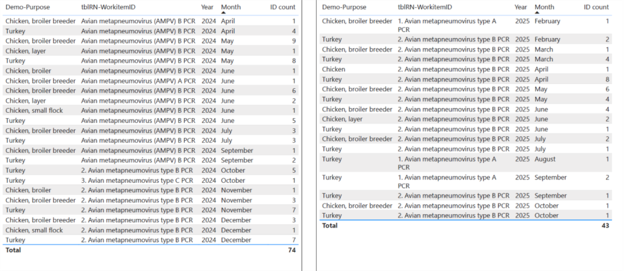
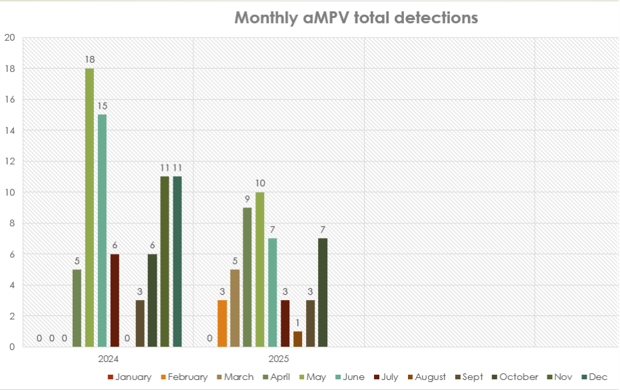
Poultry Veterinarian Survey Highlights – Q2 2025 (Mar-May 2025)
Broilers
Most of the conditions were seen stable to slightly increased this quarter.
Practitioners
Stable conditions: ILT, salmonellosis, chicken anemia virus (CAV), other causes of mortality, necrotic enteritis, lameness nutritional and developmental, coccidiosis, ascites, avian metapneumovirus (aMPV), avian influenza, histomoniasis and condemnation issues (cellulitis).
Stable to increased conditions: early and late systemic bacterial infections attributed to E. coli and E. cecorum, lameness of viral origin (reovirus), lameness of bacterial origin (E. coli and E. cecorum) and infectious bronchitis (IBV).
Stable to decreased conditions: inclusion body hepatitis (IBH), infectious bursal disease (IBDV), spiking mortality and runting stunting syndrome (RSS).
A range between 10 to 75% of E. coli isolates were described by practitioners to be resistant to TMS in broilers.
aMPV- lack of clinical signs but serology positive detection and increase in condemnation rate suspected to be attributed to aMPV infections. Identical with the last quarter, practitioners are reporting IBD, IBV and E. coli as the most encountered comorbidities detected in affected flocks.
Below graph depicts the frequency of the conditions seen in the flocks. The most frequent 3 conditions seen this quarter were:
Early systemic bacterial infection (<14 d old)
Lameness (Bacterial)
Late systemic bacterial infection (>14 d old)
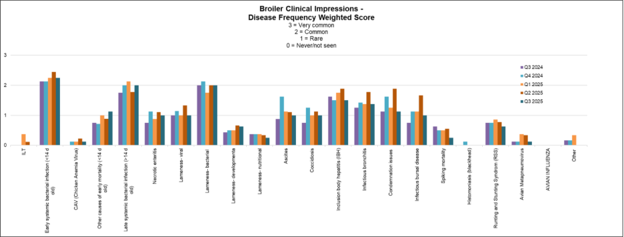
AHL
Similar number of cases (from previous quarter):
Other causes of early mortality (< 14 days old) – Penetrating foreign body (gizzard) and mycotic pneumonia/airsacculitis.
Lameness nutritional (rickets).
Coccidiosis (small intestine, ceca).
Inclusion body hepatitis (FAdVE/FAdVAC, FAdVD/FAdVAC, FAdVE/FAdVD/FAdVAC, FAdV08b_AHL_16-049095_ON, FAdV08b_AHL_18-057921_ON and FAdV11_USA_1047).
Increased number of cases (from previous quarter):
Late systemic bacterial infection (> 14 days old) – E. coli and E. cecorum isolated either in pure culture or in combination. E. coli also isolated with P. aeruginosa.
Lameness viral (Reovirus confirmed: ON_variant_H_18-008168, BC-17-0408-2017, ON_variant_A_12-073195, ON_variant_F_12-087411 and Pennsylvania 13-095523).
Lameness viral (Reovirus suspicious, primarily diagnosed on histology).
Infectious bursal disease (PCR positive field strains: USA PA105-2014, British Columbia 15-062782, USA Del-E, USA OH-Sel1-2012 and ON 05-SA08-03-25355. Vaccine strains: UK Faragher52-70 and USA W2512-Blen. Other: USA Edgar).
Spiking mortality.
Decreased number of cases (from previous quarter):
Early systemic bacterial infection (< 14 days old) – All cases of septicemia had E. coli isolated either in pure culture or with E. cecorum with or without P. aeruginosa.
Lameness developmental (tibial dyschondroplasia).
Lameness bacterial (Primarily diagnosed on histology) – E. coli or E. cecorum isolated either in pure culture or in combination. Also, E. coli and E. cecorum isolated with Staphylococcus hyicus. Two cases of osteomyelitis had E. coli and E. cecorum isolated.
Infectious bronchitis (IBV – pathology cases and PCR positive) (Field strains: IBV_DMV_ON_21-017385 and IBV_DMV_ON_15-077145. Vaccine strains: IBV_Conn, IBV_Mass-MA5 and USA Mass-AHL 21-008165 vaccine.)
RSS – Confirmed.
RSS – Suspect.
No cases diagnosed this quarter:
Necrotic enteritis.
Avian metapneumovirus (Type B).
ILT.
Dead on arrival (DOA).
Other diagnostic findings:
Proventriculitis, proventricular glandular dilation, ventriculitis, cellulitis, pneumonia (E. coli, E. cecorum), typhlitis (E. coli) and bile duct hyperplasia.
Salmonellosis (clinical)/Salmonella isolation
Animal Health Laboratory Salmonella Isolations in Broilers (see graph below summarizing isolations by quarter periods Jan-Mar, Apr-Jun, Jul-Sep, Oct-Dec):
6 positive submissions outside of OHSFP environmental testing (Ontario Hatchery and Supply Flock Program) with 1 S. Kentucky and 5 S.Enteritidis isolated (Graph 2).
OHSFP environmental samples – S. I 8:20 :-: Z6 and S. Senftenburg were the most isolated (Graph 3 showing Jul-Sep 2025 isolations only).

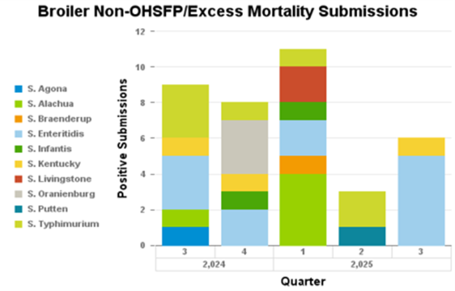
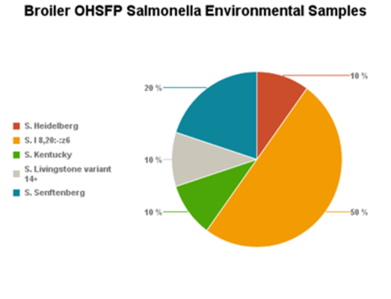
Slaughter data
Chickens slaughtered and condemned(June-August 2025)
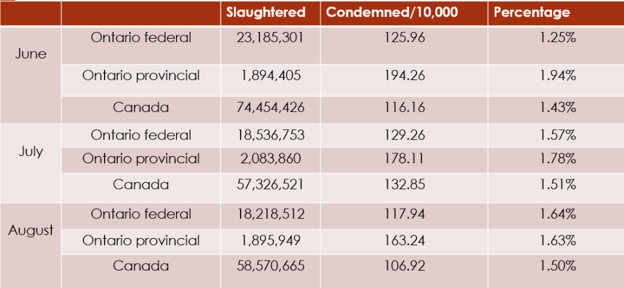
Condemnation conditions in provincial slaughter plants reported for period of June-August 2025. Top 3 conditions from provincial slaughter were: ascites, cellulitis and airsacculitis.
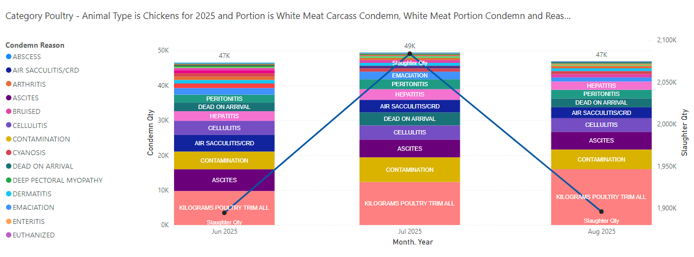
Top 3 condemnation conditions in federal establishments reported for period June-August 2025 (CAHSS data): subcutaneous lesions (79.77%), respiratory (13.75%) and abdominal oedema (13.22%).

Broiler-Breeders
Most of the conditions were reported to be stable to decreased this quarter with an increase in bacterial lameness, early systemic bacterial infections, and coccidiosis cases.
Early systemic bacterial infections were attributed to E. coli, whereas bacterial lameness agents identified were E. coli, S. aureus, and E. cecorum.
Stable conditions: CAV, ILT, salmonellosis, fowl pox, disease related to hatchability issue (white chick syndrome), multi-drug-resistant E. coli (resistant to >3 drugs), pre-lay morbidity/mortality and avian influenza.
Stable to slightly increased conditions: histomoniasis with one case observed but may have been incidental at flock level.
Stable to decreased conditions: fowl cholera, lameness developmental/viral/nutritional, IBV decreased production/egg abnormality, IBV-sudden spike in mortality, necrotic enteritis, mycoplasmosis (M. synoviae), aggression and cannibalism.
Stable with equally increased or decreased conditions: aMPV infections that were described by the practitioners as drop in production, reduced feed intake, panting, stargazing, trouble moving to feed or around barn because birds cannot see, elevated mortality, septicemia, uveitis, peritonitis, bacterial arthritis and bronchitis.
Below graph depicts the frequency of the conditions seen in the flocks. The most frequent conditions seen this quarter were:
Lameness- bacterial
Early bacterial infection (<14 d old)
In-Lay bacterial septicemia
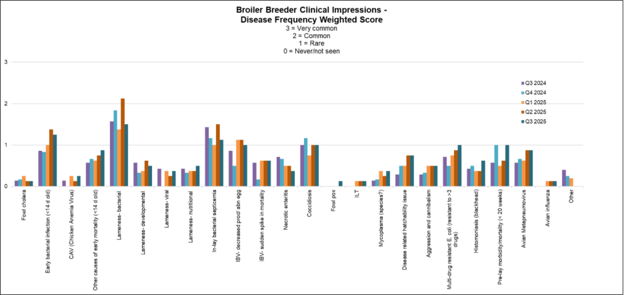
AHL
Fowl cholera (Pasteurella multocida) – Occasionally isolated from lameness cases from vaccinated flocks.
Similar number of cases (from previous quarter):
Cellulitis/Dermatitis – E. coli and E. cecorum are isolated together.
Avian metapneumovirus (Type B).
Pododermatitis – E. coli and S. aureus isolated together.
Necrotic enteritis (C. perfringens isolated).
Amyloidosis.
Increased number of cases (from previous quarter):
Prelay morbidity/mortality (<20 weeks) – S. aureus, E. coli and E. cecorum were each isolated in pure culture. S. aureus, and E. coli were isolated together. E. coli and E. cecorum were also isolated together as well as in combination with S. aureus and C. septicum. Other diagnoses included intussusception, dehydration, cannibalism and E. coli airsacculitis. Additionally, 2 strains of CAV were identified in this age group (CAV_ON_19-036180 and CAV_TW_2012-1207PT05).
Lameness developmental (valgus).
Trauma (tendon rupture).
Lameness bacterial – S. aureus, E. coli and E. cecorum were each isolated in pure culture as well as all 3 together. S. aureus and E. coli were isolated together, with or without P. aeruginosa. E. coli and E. cecorum were also isolated together. S. aureus was also isolated with either E. cecorum or S. hyicus. Cases of osteomyelitis had S. aureus isolated in pure culture, with E. coli, or with both E. coli and E. cecorum.
Coccidiosis – Identified in the small intestines or ceca.
White Chick Syndrome.
IBV (decreased productivity/abnormal eggs/sudden spike in mortality) – (CU82792 AHL 07-21349, IBV_DMV_ON_21-017385, IBV_DMV_ON_15-077145, and IBV_Mass-MA5 vaccine).
Other causes of inlay mortality – Liver hemorrhage, emaciation and ascites.
Decreased number of cases (from previous quarter):
Early bacterial infection (<14 days old) – Cases of septicemia had E. coli and E. cecorum isolated together. E. coli and P. aeruginosa were also isolated together, with either E. cecorum or S. aureus.
Inlay bacterial septicemia – E. coli and S. aureus were each isolated in pure culture as well as together, with or without Avibacterium paragallinarum spp. E. coli and E. cecorum were isolated together as well as in combination with S. aureus, G. anatis, or S. aureus and C. perfringens. In 2 cases, C. septicum was isolated in pure culture.
Bacterial pneumonia – E. coli and E. cecorum isolated together.
Intestinal parasitism – Histomonas and nematodes (Ascarids, Heterakis).
No cases diagnosed this quarter:
Other causes of mortality (> 14 days old).
Lameness nutritional (rickets).
Lameness viral – Reovirus.
Fowl pox.
Mycoplasmosis.
Urate nephrosis/visceral urates/articular urates.
Other diagnostic findings:
Gangrenous dermatitis (C. septicum / E. cecorum, S. aureus / E. coli / E. cecorum / C. perfringens, S. aureus / E. coli / E. cecorum / C. perfringens / G. anatis, C. septicum / S. aureus / E. coli / E. cecorum, C. septicum / E. coli), panuveitis / keratitis, pneumonia (E. coli, E. cecorum, mycotic), salpingitis (E. coli, E. cecorum, G. anatis) and cystic oviducts.
Salmonellosis (clinical)/Salmonella isolation
Animal Health Laboratory Salmonella Isolations in Broiler Breeders (see graph below summarizing isolations by quarter periods Jan-Mar, Apr-Jun, Jul-Sep, Oct-Dec):
5 positive submissions outside of OHSFP environmental testing (Ontario Hatchery and Supply Flock Program) with 3 S. Typhimurium, 1 S. I 4,5,12:i:-, and 1 S. I ROUGH-O:i:1,2 isolated (Graph 2).
OHSFP environmental samples – S. I 8:20 :-: Z6, S. Kentucky, and S. I 8:20 :-: Z6 were the most isolated (Graph 3 showing Apr-Jun 2025 isolations only).
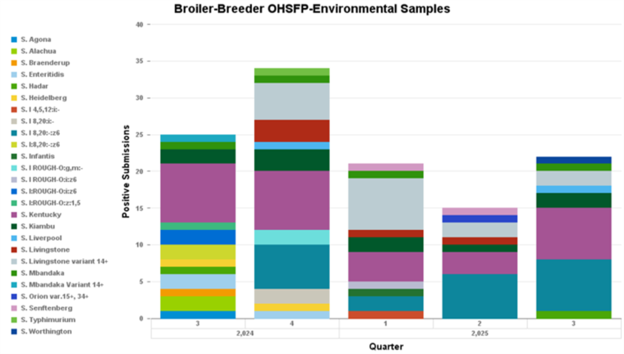
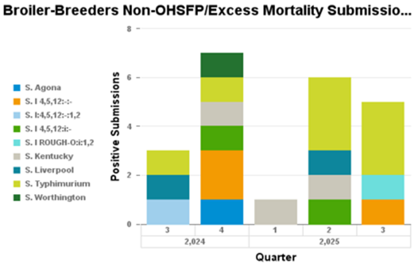
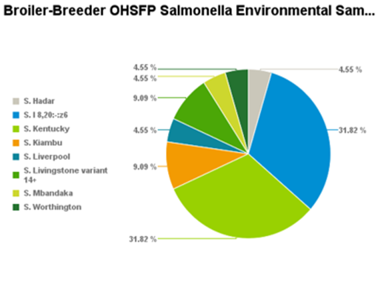
Layers
Veterinarians are reporting good, stable and solid health status in layer flocks.
Practitioners
Stable conditions: osteoporosis, bacterial peritonitis/salpingitis (E. coli and E. cecorum), early systemic bacterial infection, other causes of mortality, IBV-production/abnormal egg, IBV- respiratory issues, salmonellosis, ILT, mycoplasmosis (Mycoplasma synoviae), hysteria, aggression and cannibalism, multi-drug-resistant E. coli (resistant to > 3 drugs), histomoniasis, aMPV infections, coccidiosis, necrotic enteritis and avian influenza.
Stable to decreased conditions: focal duodenal necrosis (FDN).
aMPV infections were correlated with two main comorbidities such as E. coli in brown birds and IBV in white birds. As part of clinical signs, practitioners are reporting neurological signs and reduced egg production.
Below graph depicts the frequency of the conditions seen in the flocks. The most frequent conditions seen this quarter were:
Bacterial peritonitis/ salpingitis
Avian Metapneumovirus
Osteoporosis; IBV- prod drop/abnormal eggs; aggression and cannibalism.
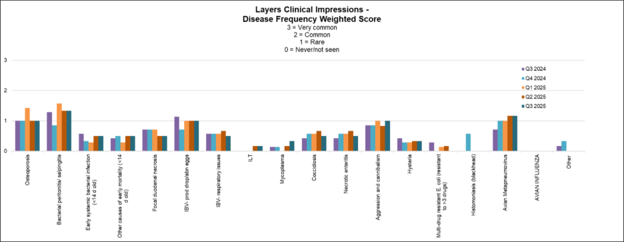
AHL
Similar number of cases (from previous quarter):
Prelay mortality (<20 weeks old) – Septicemia (E. coli, E. cecorum, G. anatis).
Coccidiosis (Small intestine).
Increased number of cases (from previous quarter):
Early mortality (<14 days old, omphalitis).
Early mortality (other) – Yolk sacculitis.
In-lay mortality (>20 weeks old) – Septicemia (E. coli with or without G. anatis), pneumonia (E. coli / G. anatis, E. coli / E. cecorum / G. anatis) and salpingitis.
Leg issues – Bacterial (tenosynovitis).
Necrotic enteritis (C. perfringens).
Avian metapneumovirus (Type B – PCR positive).
Decreased number of cases (from previous quarter):
Infectious bronchitis (IBV – production drop/egg abnormalities/ respiratory) – No pathology cases but positive PCR (IBV_Mass-MA5 vaccine and IBV_Conn vaccine).
No cases diagnosed this quarter:
Early mortality (<14 days old, starve outs).
Osteoporosis.
Leg issues – Trauma, bone fracture.
Leg issues (other).
Focal duodenal necrosis (FDN).
Intestinal parasitism (other).
Aggression/Hysteria.
ILT (No domestic flocks, spent hens at slaughter).
Mycoplasma.
Elevated DOA.
Other diagnostic findings:
Cellulitis and an 8-week-old flock positive for CAV and IBDV.
Salmonellosis (clinical)/Salmonella isolation
Animal Health Laboratory Salmonella Isolations in Layers (see graph below summarizing isolations by quarter periods Jan-Mar, Apr-Jun, Jul-Sep, Oct-Dec):
There were no positive submissions outside of OHSFP environmental testing (Ontario Hatchery and Supply Flock Program) this quarter.
OHSFP environmental samples – S. Agona and S. Thompson were the most isolated (Graph 2 showing Jul-Sep 2025 isolations only).
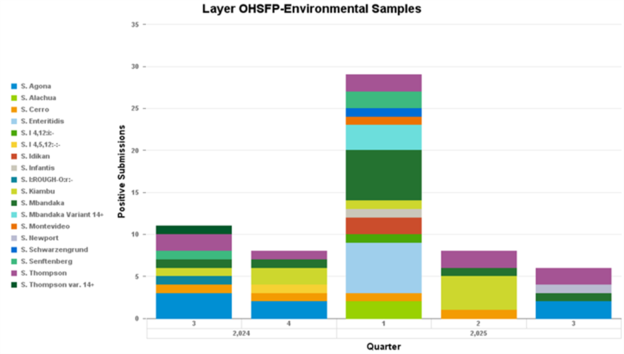
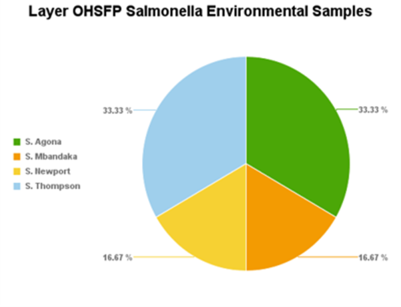
Turkeys
Practitioners
Turkey flock conditions were mostly stable this quarter. aMPV infections continue to be detected in the flocks but to a lesser extent compared with last quarter. This might be attributed to environmental conditions with better ventilation in the barns during the summer months.
Stable conditions: fowl cholera, erysipelas, early systemic bacterial infection (yolk sacculitis and E. coli) other causes of mortality (predation), mycotic respiratory disease, other respiratory disease , necrotic enteritis, enteritis, coccidiosis (Eimeria meleagrimitis) , round heart, multi drug resistant E. coli (resistant to > 3 drugs), mycoplasmosis, avian influenza, aggression, and cannibalism.
Stable to decreased conditions: ORT, reovirus tenosynovitis, late systemic bacterial infection (E. coli) and histomoniasis (two cases).
Stable to slightly increased conditions: salmonellosis and mycoplasmosis .
aMPV: stable with an equal number of respondents reporting as increased and decreased condition.
Secondary lesions (respiratory and septic) in aMPV infected flocks were related to E. coli and Ornithobacterium rhinotracheale (ORT) comorbidities.
Below graph depicts the frequency of the conditions seen in the flocks. The most frequent 3 conditions seen this quarter were:
Avian Metapneumovirus
Late systemic bacterial infection (>14 d old)
Early systemic bacterial infection (<14 d old)

AHL
Similar number of cases (from previous quarter):
Tibial dyschondroplasia.
Increased number of cases (from previous quarter):
Bacterial pneumonia – airsacculitis.
Enteric disease – Salmonella Infantis enteritis.
Coccidiosis/ Parasitism – small intestine or ceca.
Histomoniasis.
Decreased number of cases (from previous quarter):
Late systemic bacterial infection (>14 d old) – E. coli isolated in pure culture or in combination with Salmonella Montevideo.
Avian metapneumovirus – Type B. Also Type A that may be vaccine related.
No cases diagnosed this quarter:
Fowl cholera (Pasteurella multocida).
Erysipelas.
Other causes of early mortality (<14 days old, starve out / dehydration).
Early systemic bacterial infection (<14 days old).
ORT (Ornithobacterium rhinotracheale).
Mycotic respiratory disease.
Necrotic enteritis.
Rickets.
Reovirus.
Condemnations.
DOA.
Mycoplasma.
Other diagnostic findings:
Ulcerative ventriculitis, tenosynovitis (E. coli), chondrodystrophy, keratitis / anterior uveitis, viral hepatitis (either TVH or reovirus), vaccine reaction (granulomatous cellulitis and myositis) and lymphoplasmacytic epicarditis.
Salmonellosis (clinical)/Salmonella isolation
Animal Health Laboratory Salmonella Isolations in Turkeys (see graph below summarizing isolations by quarter periods Jan-Mar, Apr-Jun, Jul-Sep, Oct-Dec):
11 positive submissions outside of OHSFP environmental testing (Ontario Hatchery and Supply Flock Program) with 2 S. Lille, 2 S. Infantis, 1 S. Thompson, 1 S. Uganda, 1 S. Orion, 1 S. Montevideo, 1 S. I:47:z4,z23:- and 2 S.Agona isolated (Graph 2).
OHSFP environmental samples – S. Hadar, S. Kentucky, and S. Livingstone variant 14+ most isolated (Graph 3 showing Jul-Sep 2025 isolations only).
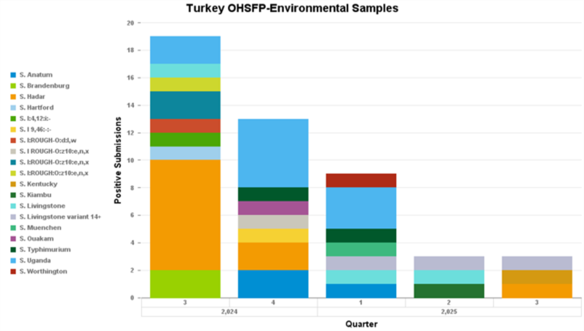
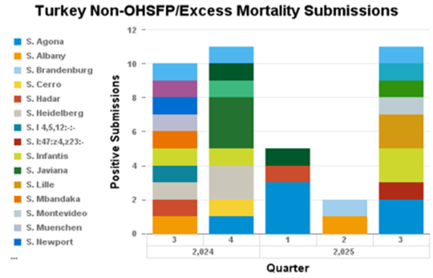

Slaughter data
Ontario provincial slaughter plants:
Turkey slaughtered and condemnation percentage (June-August 2025).

Turkey condemnation conditions (June-August 2025). Top 3 main conditions listed for this quarter were: peritonitis, airsacculitis and hepatitis.
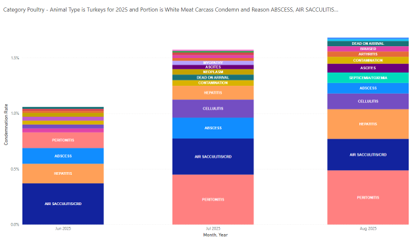
Federal establishments (CAHSS Federally Inspected Slaughter Data), June-August 2025
Top 3 main conditions listed for this quarter were: subcutaneous lesions (10.72 %), “other” (10.50 %) and emaciation (3.88 %).

Small Flock
Chickens:
AHL: Diagnoses at AHL included external parasitism (lice), intestinal parasitism (coccidiosis, nematodes, cecal parasitism, cestode), Marek’s disease, neoplasia (adenocarcinoma), salpingitis, conjunctivitis/bronchitis/sinusitis, cannibalism, emaciation, mild pericardial effusion, and scoliosis.
ILT: 1 case (PCR, too weak to type).
Gamebirds:
AHL: Two quail and one peafowl/pheasant cases submitted this quarter.
Quail:
1) Airsacculitis (mycotic, E. coli, S. aureus)
2) Aspergillosis chevalieri
3) Coccidiosis, small intestine.
4) E. coli granulomas
Peafowl/pheasant:
1) Urate nephrosis
Waterfowl:
AHL: Four duck cases submitted this quarter.
Ducks:
1) Duck – embolic hepatitis.
2) Muscovy – E. coli septicemia.
3) Muscovy – E. coli septicemia, cecal parasitism (protozoa).
4) Muscovy – liver hemorrhage, testicular round cell tumor (suspect seminoma).
Turkey:
AHL: One turkey case submitted this quarter.
1) Yolk sacculitis.
Practitioners: Information provided with the clinical impression in chickens and waterfowl:
Frequency of conditions seen in practice:
Common: Other neoplasia (coelomic masses, digital mass), pododermatitis, peritonitis/salpingitis.
Rare: Ectoparasitism, intestinal parasitism, GI impaction (crop stasis of unknown cause), ascites, other (nystagmus and lameness of unknown cause in a duck).
Not seen: Marek’s disease, trauma, vent trauma, bacterial septicemia, FLHS, toxins, pneumonia/airsacculitis, urate nephrosis/ visceral urates, articular urate deposits, ILT, histomoniasis, erysipelas, Mycoplasma and aMPV.
Changes since last quarter:
Stable conditions: ectoparasitism, GI impaction, pododermatitis, peritonitis/salpingitis, other (waterfowl)
Increased conditions: intestinal parasitism, other neoplasia.
Poultry research from Ontario and beyond
Events and News
Poultry Industry Council events: https://www.poultryindustrycouncil.ca/events Poultry Health Research Network information, events, and lectures can be accessed on the PHRN website: https://phrn.net/ or on the PHRN YouTube channel: https://www.youtube.com/user/PoultryHRN
Thank You! We thank the following poultry veterinarians who completed the veterinary survey:
Dr. Tim Abolarin, Dr. Elizabeth Black, Dr. Joanne Dias, Dr. Daniella Di Pirro, Dr. Fernando Salgado-Bierman, Dr. Shahbaz Haq, Dr. Elana Huong, Dr. Anastasia Novy, Dr. Mike Petrik, Dr. Joanne Rafuse, Dr. Nahal Ramezani, Dr. Ben Schlegel, Dr. Chanelle Taylor, Dr. Brenna Tuer, Dr. Alex Weisz, and Dr. Jessalyn Walkey. Small Flock: Dr. Amari Patel and Dr. Janice Vannevel.


